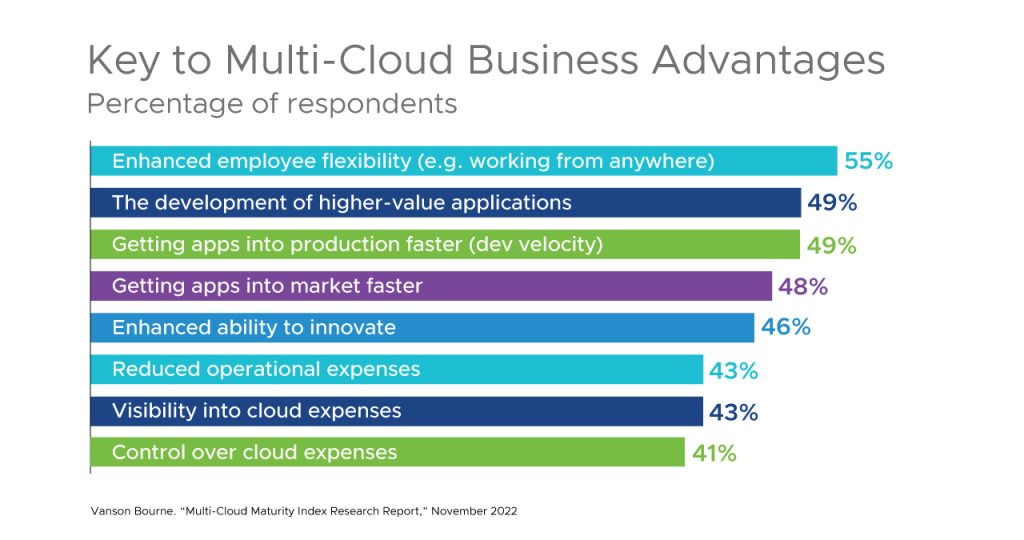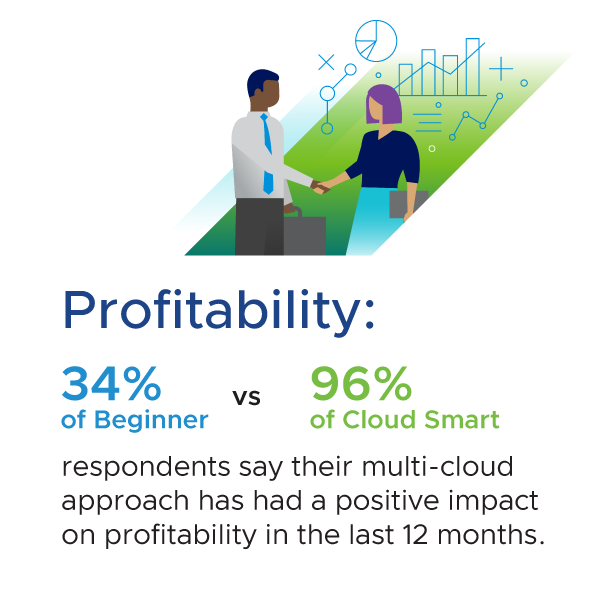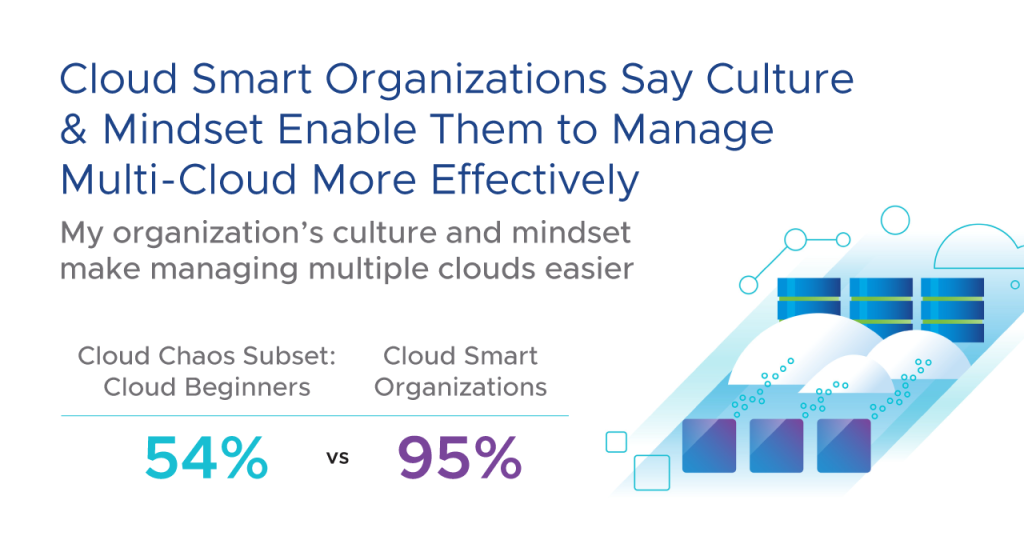The enterprise digitalization boom isn’t stopping but it is changing gears.
Companies across the world are facing a new global reality; a realization that is pressuring them to pivot—again. Steady growth is becoming harder to achieve and organizations are refocusing on productivity. The next phase of digitalization, according to the Gartner Research Board, is “putting the new digital technology to work.”
Despite several years of large investment—much of it in cloud-based systems—many organizations have yet to reap all the promised rewards of their existing technologies. Complexity and high costs remain key challenges. What these companies now need are strategies that not only simplify cloud infrastructure management and application development but deliver better business outcomes.
In short, they need to become cloud smart, passing the tipping point where multi-cloud benefits overtake implementation challenges.
CIOs, CTOs and other business technology leaders are keenly aware of multi-cloud’s untapped potential. Yet to make gains faster, multi-cloud needs to be more than an IT project. New research, commissioned by VMware and conducted by Vanson Bourne, shows that CEOs and other senior leaders have an outsized role to play in getting the right strategies in place.
Globally, nearly two-thirds (61%) of organizations that have taken a more mature, sophisticated cloud smart approach, say their CEOs are “extremely” engaged in cloud, compared to fewer than half (45%) of CEOs in “cloud beginner” organizations, the research shows.
What steps can CIOs, CTOs and other technical team members take to get the buy-in they need from their CEOs to turn multi-cloud into a winning strategy? The following three are good places to start.
- Define and effectively communicate your strategy
For CEOs, board members and other senior business leaders to take multi-cloud seriously as a business accelerator, the cloud strategy needs to be backed by a business strategy and move beyond point solutions.
Organizations have embraced multi-cloud in big numbers. According to the Multi-Cloud Maturity Index Research Report, multi-cloud adoption* worldwide is running at 64%, a giant leap from 38% just two years ago. But in many cases, cloud strategies have not kept up with business visions. Data remains siloed and visibility into data limited, preventing teams from realizing data’s full value. Management and security challenges, including ransomware attacks, also have increased as the number of clouds has multiplied.
Despite the high rate of multi-cloud adoption, only 31% of the 5,790 organizations worldwide surveyed say they have a “fully defined” multi-cloud strategy in place with only 19% of all organizations categorized as cloud smart. At 21%, companies in the Asia-Pacific region—followed closely by EMEA—are leading the cloud-smart charge compared to those in North America but there’s plenty of room for improvement across the regions.
There’s a big disconnect everywhere between adoption and strategy, leading to cloud chaos—widely dispersed, hard-to-manage cloud environments that bring unnecessarily increased complexity and higher costs.
For technical leaders, defining a cohesive strategy that addresses the entire multi-cloud data estate in a way that senior executives, particularly CEOs, can understand and support is key to getting the backing and budget to become cloud smart and unlock all the economic and operational benefits of multi-cloud.
- Sell multi-cloud’s benefits
The benefits of multi-cloud to enterprises are significant and wide reaching, but they haven’t been well articulated to senior business leaders. According to the Multi-Cloud Maturity Index Research Report, organizations worldwide most often cited enhanced employee flexibility—a non-negotiable in the era of hybrid work—as a key business advantage of multi-cloud.
Survey respondents also say multi-cloud is helping their organizations:
- Develop higher value applications.
- Get applications into production and market faster.
- Enhance their ability to innovate.
- Reduce operational expenses.

What CEOs who are less involved and uninvolved in multi-cloud may not realize that technical leaders can bring forward is that being cloud smart multiplies the benefits.
One example of this accumulating benefit is 92% of cloud-smart organizations saying they find it easier to manage data, wherever it resides. This can give a boost to an organization’s data protection and compliance efforts. Cloud-smart organizations also agree they are far more likely to see a positive financial impact from multi-cloud.
A full 97% of private cloud-smart organizations say their multi-cloud approach has had a positive impact on revenue growth in the last 12 months, compared to just 51% of organizations at the beginning of their cloud journeys, according to the Multi-Cloud Maturity Index Research Report. Positive impact on profitability over the same period is even more pronounced. A full 96% of private cloud-smart organizations say their profitability has been enhanced by multi-cloud, compared to just 34% of cloud-beginner organizations.


Cloud-smart organizations are more likely than cloud beginners to say that monetizing data is currently a “significant” source of revenue.
As CEOs pivot their thinking to productivity, having them understand the full potential of multi-cloud as a growth driver is important. Being cloud smart creates the path for multi-cloud to deliver positive outcomes against a wider variety of business objectives. The vast majority of cloud-smart organizations worldwide surveyed say that multi-cloud architecture has become critical to success, and that organizations that don’t adopt this approach risk failure.
In addition to discovering the significant benefits of adopting multi-cloud and becoming cloud smart, CEOs and other senior leaders should be made aware of the risks of taking on multi-cloud without the right platform and partner.
3. Build a multi-cloud culture and mindset
At VMware, it’s our mission to help organizations become cloud smart. That’s why we’re innovating with platform solutions such as VMware Tanzu, VMware Cloud and VMware Aria that remove complexity for organizations’ app development and delivery, application migration and hosting as well as cloud management teams.
Yet technology always works best when it is backed by culture and processes that support it. Cloud chaos is a business problem as much as a technology challenge. While 95% of cloud-smart organizations worldwide say they institute a mindset and culture that makes managing multiple clouds easier, just over half (54%) of cloud-beginner organizations say the same.

The support of the CEO and senior business leadership is vital to growing and embedding a culture of improvement, but technology leadership plays a vital role in creating the conditions for improvement powered by multi-cloud to thrive. That includes leaders getting out from behind their desks and talking to the business about multi-cloud: How it can help align goals; how it can improve time to market; and its role in not only scaling growth but increasing efficiency.
Through discussions like these, technology leaders can help end the isolated decision making that allows cloud chaos to flourish. They can work more closely with business leaders to make the multi-cloud culture part of the business strategy.
Becoming a cloud-smart business
CEO engagement is critical to the success of multi-cloud strategies, according to organizations surveyed for the Multi-Cloud Maturity Index Research Report. Organizations whose CEOs are leaning into multi-cloud are reaping the benefits—both in the maturity of their infrastructure and on the bottom line. They’re also better positioned to adapt to changing markets and economies.
But CEOs need the rest of the organization—technical plus business leaders and teams alike—to step up as well to most effectively drive multi-cloud forward, faster.
For the majority of organizations worldwide, being cloud smart is still a goal yet to be achieved. And as they undertake the journey to get there, it’s important that every part of the business be on board.
*Organizations that have two or more different public cloud vendors currently.
